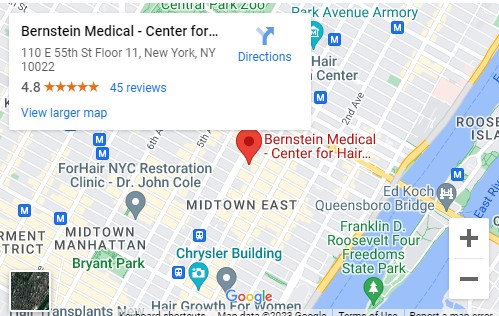SUMMARY of Dr. Bernstein’s editorial commentary on Hwang SM et al. Does the Recipient Site Influence Hair Growth Characteristics in Hair Transplantation? The original article appeared in Dermatol Surg 2002; 28(9): 798-99.
The field of hair transplantation in the United States began with Dr. Norman Orentreich’s famous 1959 paper on Donor Dominance. In it, he declared that in hereditary baldness, hair maintains the characteristics of where it was taken from, regardless of were in the scalp it is placed. This is because the genetic predisposition for hair loss resides in the follicle, rather than in the scalp.
A number of years ago, Dr. O’Tar Norwood, of the famed Norwood Classification, observed that non-wavy transplanted hair can become wavy when transplanted in a balding spot that was once wavy. To discover that transplanted hair could “wave” was a strong argument that the receiving area (or “recipient site”) influenced the growth of the hair transplant. We know this because a hair restoration surgeon is not capable of orienting hair so that it will form a perfect wave.
In 1999, Dr. Lee transplanted hair from a person’s scalp to the person’s eyebrows. He discovered that the transplanted eyebrows grew at a slower rate, conforming to the eyebrow pattern instead of the scalp where it came from.
The current study, conducted by Dr. Hwang, is the third compelling challenge to Dr. Orentreich’s famous once iron-clad hypothesis on hair transplantation. This is how they did it: Dr. Hwang had hair from his own scalp transplanted to his leg. The scalp hairs began to look and act like the other hairs on his leg. Furthermore, when the hairs where transplanted back to his head they began to change again! Finally, we had real scientific proof that grafts from a hair transplant are influenced by their transplant destination.
As hair transplant surgeons find new areas of the body to take hair from and new places to transplant it to, the role that the recipient site plays becomes more significant. Perhaps, a bald man with a thick beard could have his chin hair inserted into his scalp and see it grow to a similar look and feel of his original hair. Imagine how comforting it would be to a female having an eyebrow hair transplant to see that the hair growth would slow down and that she could finally stop trimming it.
The most exciting possibilities regarding the recipient site influencing the hair transplant are still to come. When hair cloning is finally a reality, it will probably be performed much like Dr. Jahoda envisions it; where a genetic component of the follicle is multiplied and then used to stimulate the rest of the follicle within the living organism.
Dr. Jahoda discovered that cells from particular parts of a hair follicle could generate the growth of a complete hair. These cells, called fibroblasts, are easily grown in test tubes, so in theory at least, they could be produced in an unlimited supply. His experiments also indicate that the new cells could be transferred from one person to another, without being rejected by the recipient’s immune system. The main determining factor of successful hair transplants with cloning would be the ability of a patient’s recipient area to produce follicles stimulated by these types of cells and have them grow in a way that will look cosmetically appealing.
So far these experiments are only indications of what could be possible. In the future, if hair transplants using cloned hair does become a reality, discovering exactly how the recipient area alters the follicle, and how it affects the look and feel of growing hair, will decide whether or not this technology will be acceptable to hair transplant patients.
We have seen a large number of changes in surgical hair restoration over the past 4 decades, but we have always believed that Dr. Orentreich’s theory – that during a hair transplant the donor area sets the rules on how the transplanted hair would behave – was an absolute truth. Now that our “truth” about donor dominance has given way to the newly discovered power of the recipient site, what other long held “truth” about hair transplantation will crumble?




